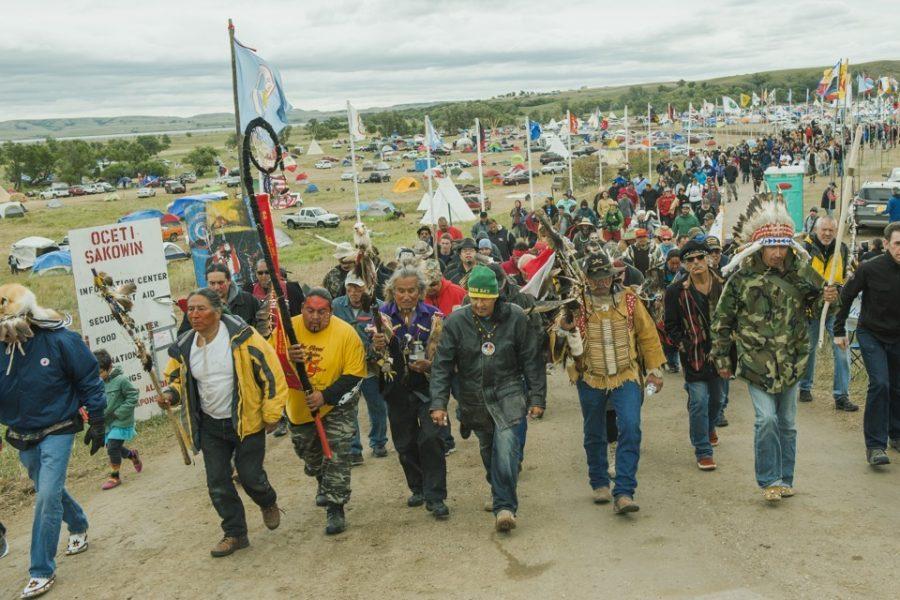The North Dakota Access Pipeline
In recent months the debate over the Dakota Access Pipeline has become a flash point for larger debates on environmental issues, the regulation of big business, and the rights of Native Americans to land and water.
First proposed in 2014, the Dakota Access Pipeline is a massive endeavor by Energy Transfer Partners, a Dallas-based energy conglomerate. Stretching 1,172 miles through four states, the proposed pipeline would connect the Brakken and Three Forks production areas in North Dakota to Patoka, Illinois. This would allow US-produced, light sweet crude oil from North Dakota to reach major refining markets. The pipeline would have the capacity to carry approximately 470,000 barrels per day. That would be the equivalent of 374.3 million gallons of gasoline a day. The pipeline was set to be finished by the end of 2016 but this deadline is now up in the air based on the uncertainty of government approvals.
Those who support the building of the pipeline argue that it will have far-reaching economic benefits and therefore should be approved. Supporters assert that it would create about 8,000-12,000 temporary construction jobs with a possibility of 40 permanent operating jobs. By the Energy Transfer Partner’s calculations, the state and local government will gain $169 million in state and income tax revenue. The creation of the pipeline would expand the oil industry of the area by carrying half of Brakken’s oil to production. The main impact would be to give shippers more market access, including Midwest and East Coast markets as well as the Gulf Coast through the Nederland, Texas. Those for the pipeline are not concerned with the pipeline’s impact on the environment saying it will be in accordance with the Code of Federal Regulations Part 195.
The pipeline has faced very strong opposition from many groups of people. Many people are uniting with the Standing Rock Sioux tribe, who have been a leading force in the fight against the pipeline. Though the pipeline isn’t planned to be on the reservation, tribal leaders say that the company and government broke federal laws by not adequately engaging with the tribe during the permit process. The planned location goes through a sacred burial ground and the Missouri River. The river is the main source of drinking water for the tribe and even the slightest leak could damage the supply, although the builders of the pipeline say they have safeguarded against leaks. 3,300 incidents of pipeline leaks have been reported by The Hazardous Materials Safety Administration since 2010. On a broader scale, environmentalists are against the pipeline, saying it would contribute to man-made climate change by building up the country’s oil infrastructure.
Protests have been conducted in the form of visible demonstrations and legal action. Thousands of demonstrators have gathered at construction sites and nearby encampments. Among these people are many public figures such as Shailene Woodley. The multitude of groups have made promises to continue to protest through the winter, with average temperatures reaching below zero. The protesters have also made a movement using legal action. The tribe has sued the Army Corps of Engineers saying that the pipeline doesn’t agree with the National Historic Preservation Act (NHPA) and the National Environmental Policy Act (NEPA) . The NHPA requires the agency to consider the cultural significance of federally-permitted sites and the NEPA states that by law consideration must be made as to the implications for the waterways.
In September, construction of the pipeline was blocked by The Obama administration along with Army Corps of Engineers, the Department of Justice and the Department of Interior with hopes of being able to conduct a review. However, a federal court reversed the decision, allowing the project to proceed. Obama himself has told tribal leaders that their “Voices were being heard,” though he hasn’t taken an official stance on the issue. President Elect Donald Trump has said in person and in his party’s platform that he wants regulations on oil and gas companies to be removed but hasn’t mentioned the pipeline directly. He does own stock in company building the pipeline, Energy Transfer Partners.
As the pipeline debate continues it has become clear that no matter what the result of the pipeline is it will be an important one in the hot button issues of climate change and environmental preservation, business regulations, and the rights of Native Americans to their land.













